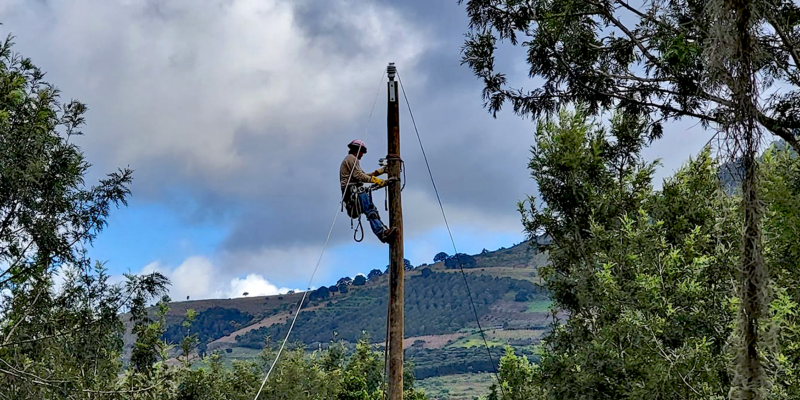CFC, NCSC Grants Help Florida Co-ops Power Guatemala

Powering Guatemala, A Sunshine State Project, was the first international electrification trip taken by Florida’s electric cooperatives. When the team of 14 cooperative employees from six systems brought power to the small, rural village of Guishoro in Jalapa, Guatemala, in mid-December, it was the successful conclusion of a project over five years in the making.
Project participants included Choctawhatchee Electric (CHELCO), Clay Electric, Florida Keys Electric, Glades Electric, Peace River (PRECO), SECO Energy, Seminole Electric (Seminole), Talquin Electric, Tri-County and Withlacoochee River (WREC). All of the systems provided funding support and six cooperatives sent personnel. The project was coordinated by Seminole, a Florida-based generation and transmission cooperative, with support from the Florida Electric Cooperatives Association (FECA).
CFC and NCSC were proud to support the endeavor with grants totaling $95,000, which were used for all aspects of the project, including material, travel and lodging for the volunteers. “Without the financial support of CFC, NCSC and our other valued partners, this project would have not been possible,” WREC team leader David Lambert noted.
 Source: Ryan White, Seminole Electric Cooperative.
Source: Ryan White, Seminole Electric Cooperative.
Co-op Action and Commitment to Community
The idea of Florida cooperatives joining the international electrification effort was first brought up in 2017 by Steve Rhodes, CEO of CHELCO and a current NCSC board member. Rhodes had experienced the significance of international electrification efforts while CEO at Kosciusko REMC in Indiana, which participated in a Hoosiers Power the World project in Guatemala in 2012.
“We all know the history of electric cooperatives being formed in the 1930s and 1940s to provide life-changing electrification in rural America,” Rhodes said. “Today, we are the beneficiaries of that legacy. Given the many blessings we enjoy as Americans, it seems only right and fitting that we should extend those benefits to others that are less fortunate around the world. It is a gift that will keep on giving for generations.”
“We talk a lot about community, and commitment to the community, and a lot of the time we think about it in terms of our local community at home back in Florida,” Seminole Electric CEO Lisa Johnson said. “But community is the world, and so for our employees to know that they had a part in this trip, whether they were directly involved, or just because they’re part of Seminole Electric Cooperative, they were part of supporting this project, and they were part of opening up our community to Guatemala and to the rest of the world.”
Pandemic Delays, Other Obstacles
Team Florida was originally scheduled to head to Guatemala in 2020, but their trip, like many others that year and the next, was delayed multiple times due to the pandemic.
When they finally arrived in the village of Guishoro, about 90 miles northeast of Guatemala City, they were enthusiastically greeted by the villagers.
“I do not know a whole lot of Spanish, but a smile is a smile in any language,” CHELCO line worker Jason Price said.
Although the 31 primary distribution poles had already been set prior to the team arriving, the project plan had to be modified when the team saw the route of the poles along Guishoro’s winding, mountain-side roads. To increase safety, the poles required multiple anchors to be installed that were not originally planned.
Volunteers from the village and workers from the local municipal utility, Empresa Eléctrica Municipal De Jalapa, worked alongside Team Florida to dig the anchor holes and set the 12-meter poles.
The Florida line workers then attached nearly two miles of primary conductor, as well as a mile of secondary conductor. Four transformers were also hung and connected, all by hand and without bucket trucks.
“The cohesiveness of these guys is unmatched. We all come from different co-ops with different ideas and work processes, but once we sat down together and figured out what we needed to get done, it seemed to gel really well,” said Jamen Monbarren, WREC’s training and safety director. “The locals, the villagers, were a huge advantage for us. I don’t know how much we would have gotten done without them. They were a great asset to this project.”
“Pulling wire through these treacherous roads is tough,” WREC line worker Patrick Sullivan added. “I have never climbed next to a volcano or on the edge of a mountain road with a cliff next to it. It was different, but very enjoyable.”
Team Florida also wired the villagers’ homes with light sockets, outlets and switches.
On December 13, after 10 days of hard work, the moment arrived to energize the lines. In total, 22 village homes received electricity for the first time.
“I will never beat this experience and the blessing it was to me when we turned the lights on for those villagers. It was a proud moment for me, the highlight of my career,” Clay Electric Cooperative line worker Damian Stewart said. “We gave the kids some cardboard cutout trucks, some crayons and every house got at least two Clay Electric night lights in them. When the lights came on, they knew Clay Electric was there.”
 Source: Ryan White, Seminole Electric Cooperative.
Source: Ryan White, Seminole Electric Cooperative.
Every house also received extra LED light bulbs, Christmas lights, gift baskets, blenders and toys for the children.
The team flew home December 16, just in time to celebrate the holidays with friends and family. Team Florida has a Facebook page with pictures, video and posts with the team members from throughout the trip—it is called “Powering Guatemala” and can be accessed here: https://www.facebook.com/groups/powering/.